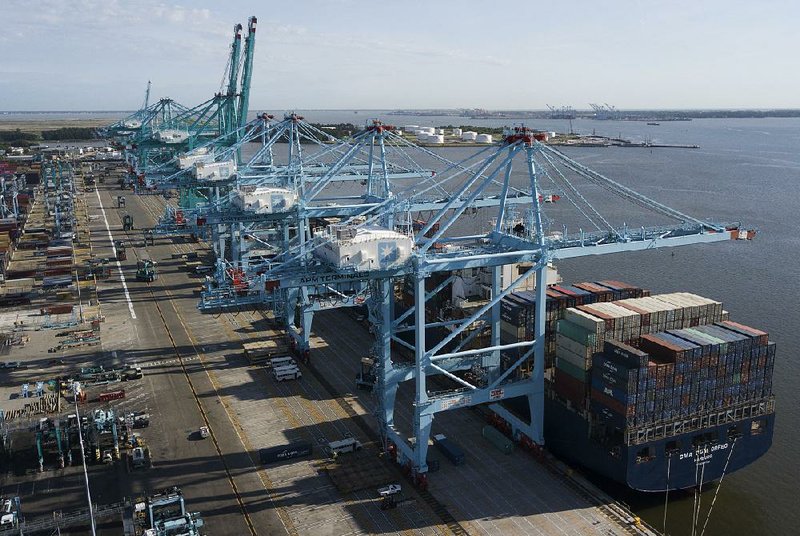WASHINGTON -- The U.S. economy grew at a solid 3.1% annual rate in the January-March quarter -- a pace that will likely prove to be the high-water mark for the year before growth weakens in the coming months.
That's the assessment widely shared by economists in light of the rising threats facing the U.S. economy, from a continuing trade war to more cautious spending by consumers and businesses to a global slowdown. Their collective forecast is that last year's 2.9% growth -- the fastest year of expansion since 2015 -- will be followed by a more tepid 2.3% gain this year.
That pace would roughly match the average annual growth since the current expansion began in 2009. In two months, it will become the longest post-recession recovery on record. But it also has been the slowest since World War II.
President Donald Trump's administration, rejecting the assessments of mainstream economists, insists that its program of tax cuts, regulatory changes and tougher enforcement of trade deals will produce dramatically higher annual growth above 3% for the next six years.
Half the 3.1% growth rate in the January-March quarter that the government reported Thursday was caused by two temporary factors: A surge in business efforts to restock shelves and a big trade deficit, but one that is expected to narrow.
In the calculations that produce the nation's gross domestic product, a widening trade deficit subtracts from growth. By contrast, a narrowing trade deficit, like the one last quarter, raises growth. Yet economists predict that the pendulum will swing back to a wider trade gap in the current April-June quarter. That's because neither a sharp drop in imports nor a big surge in exports in the first quarter is expected to persist.
For that reason, analysts foresee second-quarter growth slowing to around a 1.5% annual rate -- just about half the first-quarter figure.
U.S. stocks rose Thursday, on track for their first gain in three days, while Treasury-note prices fell and the dollar advanced.
A separate report Thursday showed pending home sales unexpectedly fell in April from the previous month, adding to signs the housing market is struggling to recover.
Excluding the trade and inventories components that gave a boost to the gross domestic product, final sales to domestic purchasers increased at a 1.5% pace -- the slowest since 2015, though revised from 1.4%. This measure, often looked to by economists as a gauge of underlying demand, suggests growth in the quarter was weaker than the headline number indicates.
Trump's signature domestic achievement was the passage of a $1.5 trillion tax cut in December 2017. Billions in additional spending for domestic and military programs that Congress approved in early 2018 also delivered a stimulative lift to the economy.
The tax cuts allowed companies, which received a major portion of the bounty, to spend more on plants and equipment. Business investment grew sharply as a result. So did stock buybacks, which helped boost the stock market.
And for households, tax cuts began showing up in paychecks early last year in the form of lower withholding amounts, leaving consumers with more money to spend. Consumer spending, which accounts for about two-thirds of economic activity, averaged a sizzling 3.3% annual rate over the final three quarters of 2018.
But the initial surge from the tax cuts and the increased government spending are waning now. That's a major reason why economists think growth this year will slow to a modest 2.3% annual pace, in line with the pattern of the past decade.
The gravest perceived threat may be the escalating trade war between the United States and China, the world's two largest economies. Stock markets have been falling since talks broke off this month and the Trump administration announced that it was boosting tariffs on $250 billion in Chinese goods. Beijing vowed to retaliate against U.S. products as it has done with previous Trump tariffs.
For economists, the concern is that the disruptions in trade could become severe enough to trigger a recession in an already weakening economy.
"If the trade war escalates, that could cause unemployment to start to rise and that could cause consumers to cut back on their spending, which would then prompt businesses to cut back," said Mark Zandi, chief economist at Moody's. "Then the recession risks become very high."
Yet Zandi said he thought that risk could fade if the United States and China can at least declare a truce in their trade war, which would keep punitive tariffs from widening further.
Economists are watching for such an outcome, with Trump and President Xi Jinping set to meet on the sidelines of a Group of 20 major nations' summit next month in Japan.
Information for this article was contributed by Martin Crutsinger of The Associated Press and by Reade Pickert of Bloomberg News.
Business on 05/31/2019
